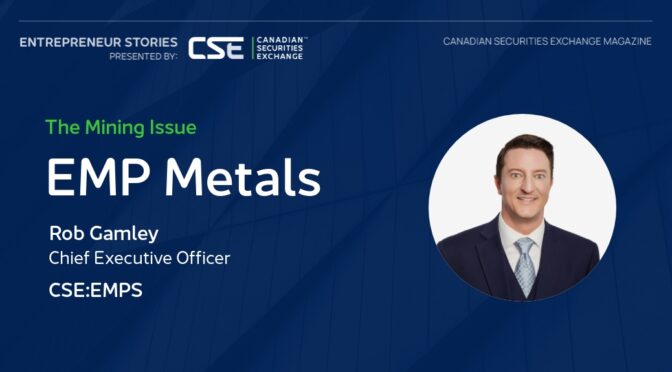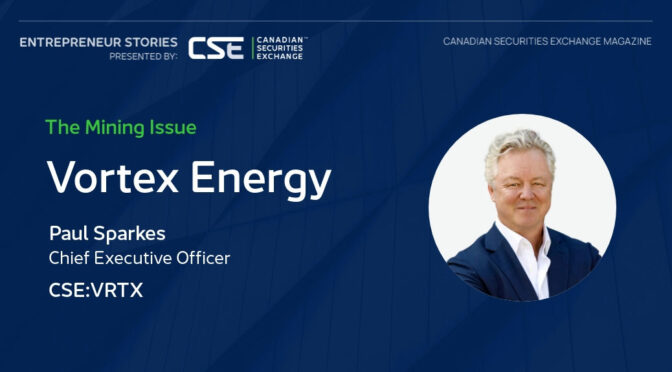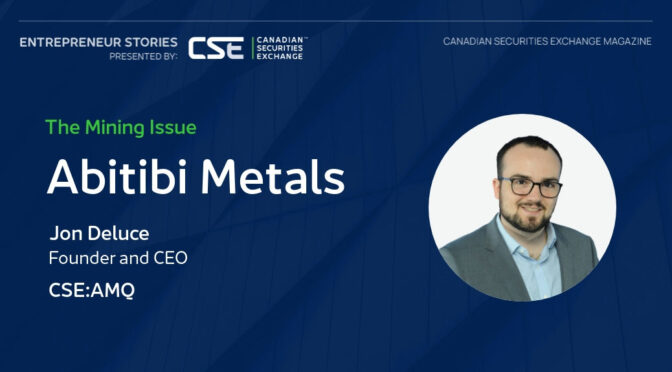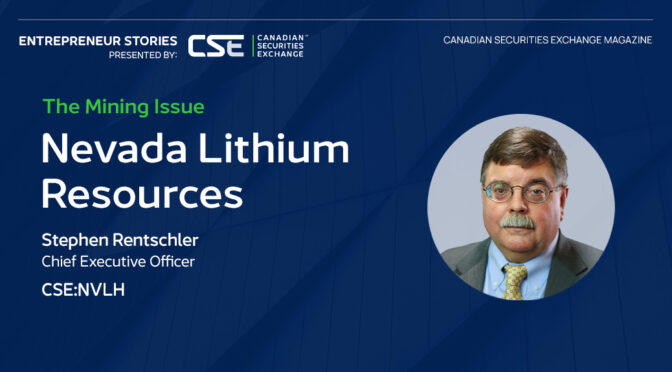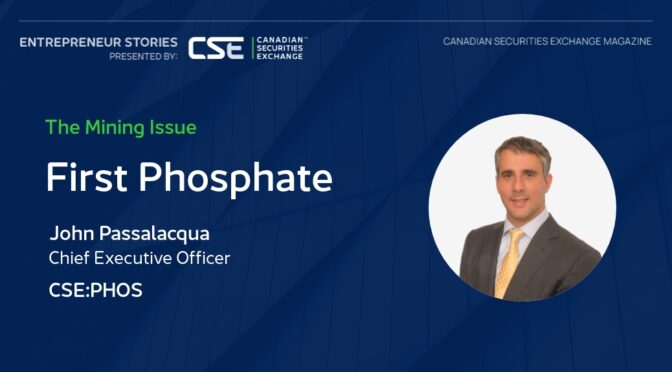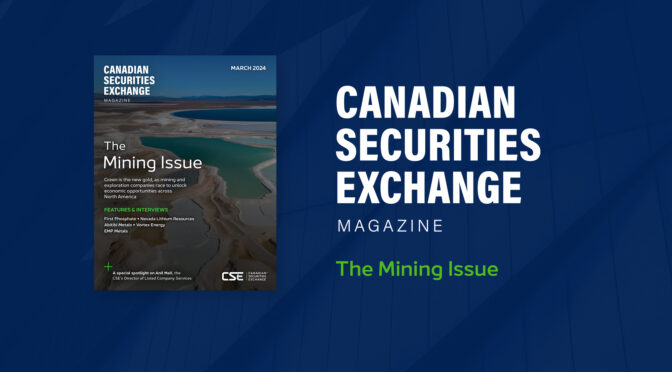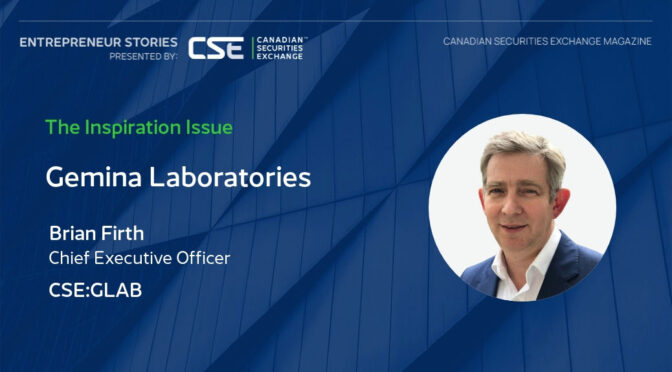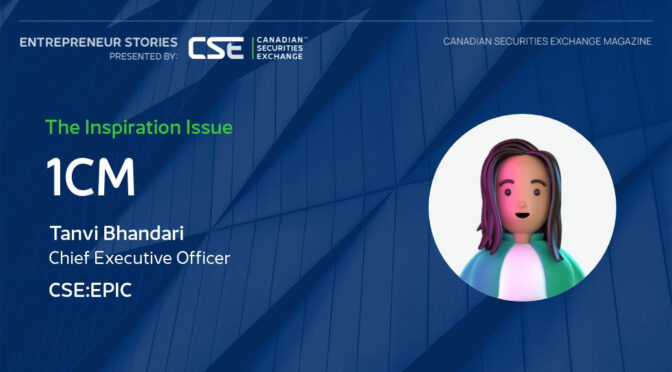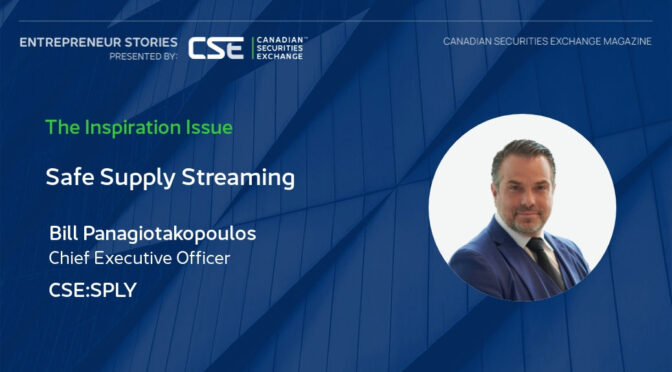January Highlights
To wrap up an incredible year, we’re sharing our favourite highlights from each month. For our first post, we’re looking all the way back to January, when Richard Carleton, CEO of the CSE, shared an important message on our blog, the CSE team attended a number of renowned events, and we released our first podcast of the year.
The “Senior” Exchange and Other Capital Market Myths Blog
In today’s challenging market, when market participants need a clear understanding of available choices, inaccurate storytelling sows unnecessary confusion.
As we entered 2024, Richard Carleton shared a special blog post, “The ‘Senior’ Exchange and Other Capital Market Myths,” to help bring clarity and dispel myths surrounding Canadian stock exchanges.
The blog post debunks “senior” exchanges, provides insight into securities laws and investing in CSE issuers, and highlights the unique qualities that set the CSE apart.
Read Now: The “Senior” Exchange and Other Capital Market Myths
VRIC 2024
On January 21-22, the Vancouver Resource Investment Conference (VRIC), presented by Jay Martin, President and CEO of Cambridge House International, made its exciting return.
The CSE was pleased to connect with friends old and new in the mining and exploration space at this action-packed event, filled with keynotes from over 100 expert speakers, a tradeshow and exhibition, extensive networking sessions, and more.
The renowned event also served as a platform for sharing our unique expertise via two CSE-hosted panels, moderated by the CSE’s Anna Serin, Director of Listings Development for Western Canada and U.S. & Vancouver Branch Lead.
The first panel, “Beyond Borders: Navigating Cross-Border Capital and Liquidity Opportunities in Resource Companies,” featured the CSE’s Richard Carleton, CEO, and Jason Paltrowitz, Executive Vice President of Corporate Services at OTC Markets Group.
The second panel, “Powering Tomorrow: Taking Stock of Global Lithium Supply in the Energy Revolution,” featured Jason Barnard, President and CEO of Foremost Clean Energy (CSE:FAT), and Scott Eldridge, CEO of United Lithium (CSE:ULTH).
Several CSE listed issuers also attended the event, including:
- Emperor Metals (CSE:AUOZ)
- Exploits Discovery (CSE:NFLD)
- Gander Gold (CSE:GAND)
- Getchell Gold (CSE:GTCH)
- Golden Cariboo Resources (CSE:GCC)
- Headwater Gold (CSE:HWG)
- Inflection Resources (CSE:AUCU)
- Nevada Lithium Resources (CSE:NVLH)
- Nevada Organic Phosphate (CSE:NOP)
- NorthX Nickel (CSE:NIX)
- Prismo Metals (CSE:PRIZ)
- Prospect Ridge Resources (CSE:PRR)
- Provenance Gold (CSE:PAU)
- Red Canyon Resources (CSE:REDC)
- Sassy Gold (CSE:SASY)
- Western Uranium & Vanadium (CSE:WUC)
The CSE’s Renowned Mining Over Canada Reception
Back by popular demand, the CSE’s annual post-VRIC Mining Over Canada Reception was even bigger and better than ever.
Held at the prestigious Vancouver Club, the Canadiana-themed networking event brought together CSE listed issuers and members of the capital markets and mining communities for an evening filled with great live music, conversation, and outstanding food and drinks.
The event was a resounding success thanks to our generous event sponsors, MNP, Odyssey Trust Company, Haywood Securities, Morton Law LLP, and Grove Corporate Services.
We hope you enjoy these photo highlights.
View the Album: Mining Over Canada 2024
The JSE 19th Regional Investments & Capital Market Conference
The CSE team enjoyed a productive break from the winter weather at the JSE 19th Regional Investments & Capital Market Conference on January 23–25 at Jamaica Pegasus Hotel in Kingston, Jamaica.
We were pleased to sponsor this three-day premier event, hosted by the Jamaica Stock Exchange, which brought together financial services industry players from around the world to examine and strategize on the sector’s most pressing topics and global trends.
The CSE’s Rob Cook, Senior Vice President of Market Development, enjoyed catching up with entrepreneurs, members of the capital markets, and our friends at the Jamaica Stock Exchange during this wonderful event.
Gwen Preston on The Exchange for Entrepreneurs Podcast
The Exchange for Entrepreneurs Podcast returned for a brand-new season this January.
In the inaugural episode, the CSE’s Anna Serin served as host for a special interview with Gwen Preston, Newsletter Writer and Mining News Blogger at Resource Maven, to discuss the mineral exploration and investment space.
Gwen Preston shared insights on what happened in the resources market in 2023; factors shaping current trends in the mining and exploration sector, including rate hikes, competition for speculative capital, and the impact of electrification; and her predictions for gold, uranium, and more.
Watch Now: Gwen Preston on Resource Trends for 2024
February Highlights
Despite being the shortest month of the year, we launched the 2024 Mining Issue of Canadian Securities Exchange Magazine, attended exciting events, had our CSE-hosted VRIC panels featured on VRIC Media, and released two episodes of The Exchange for Entrepreneurs Podcast, all this past February.
Canadian Securities Exchange Magazine: The Mining Issue
To gear up for PDAC in March, we launched the 2024 Mining Edition of Canadian Securities Exchange Magazine.
This issue offers insight into five CSE listed mining companies racing to unlock economic opportunities across North America as green becomes the new gold.
The CSE listed companies featured in this edition include:
- Abitibi Metals (CSE:AMQ)
- EMP Metals (CSE:EMPS)
- First Phosphate (CSE:PHOS)
- Nevada Lithium Resources (CSE:NVLH)
- Vortex Energy (CSE:VRTX)
Read Now: Canadian Securities Exchange Magazine: The Mining Issue
The MicroCap Conference
We had an incredible time connecting with entrepreneurs and capital markets professionals at the Microcap Conference at the Caesars Atlantic City Hotel & Casino in New Jersey on January 30-February 1, 2024.
This three-day conference provided attendees with extensive networking activities, expert panel discussions around topics critical to the microcap community, and company presentations, along with an entertaining casino experience that made the most of the venue.
It was great to see all the CSE listed issuers in attendance at this incredible event put together by DealFlow Events!
Mines and Money Miami
On February 22-23, 2024, the CSE travelled to vibrant downtown Miami, Florida to attend Mines and Money Miami.
We enjoyed connecting with friends and colleagues in the North and Latin American mining finance ecosystem over two days of programming covering today’s most pressing topics, including junior mining companies’ role in securing critical mineral supply chains for the energy transition and the impact of legislation.
Several CSE listed issuers also attended the event, including:
- American Pacific Mining (CSE:USGD)
- Champion Electric Metals (CSE:LTHM)
- Exploits Discovery (CSE:NFLD)
- PTX Metals (CSE:PTX)
- Renforth Resources (CSE:RFR)
- United Lithium (CSE:ULTH)
VRIC 2024’s CSE-Hosted Panel Replays
At VRIC 2024, we were proud to host two panels, which were moderated by the CSE’s Anna Serin, Director of Listings Development for Western Canada and U.S. & Vancouver Branch Lead.
The first panel, “Beyond Borders: Navigating Cross-Border Capital and Liquidity Opportunities in Resource Companies,” featured the CSE’s Richard Carleton, CEO, and Jason Paltrowitz, Executive Vice President of Corporate Services at OTC Markets Group.
Catch the replay on VRIC Media’s YouTube for insights into opportunities for raising capital beyond our borders, how the CSE works with the OTC to help Canadian companies access private placement capital in the U.S., and other considerations, including DTC eligibility, fungibility, and more.
Watch Now: Beyond Borders: Navigating Cross-Border Capital and Liquidity Opportunities in Resource Companies
The second panel, “Powering Tomorrow: Taking Stock of Global Lithium Supply in the Energy Revolution,” featured Jason Barnard, President and CEO of Foremost Clean Energy (CSE:FAT), and Scott Eldridge, CEO of United Lithium (CSE:ULTH).
Tune in to the replay on VRIC Media for an in-depth discussion on the interplay between lithium and electrification, the factors impacting lithium supply and demand, and shifting to domestic supply and processing in North America and Europe.
Watch Now: Powering Tomorrow: Taking Stock of Global Lithium Supply in the Energy Revolution
Jason Barnard and Scott Eldridge on The Exchange for Entrepreneurs Podcast
Jason Barnard, President and CEO of Foremost Clean Energy (CSE:FAT), and Scott Eldridge, President and CEO of United Lithium (CSE:ULTH), joined Anna Serin once again for this year’s second episode of The Exchange for Entrepreneurs Podcast.
Jason Barnard and Scott Eldridge discussed all things lithium, including factors impacting the electric vehicle market; global jurisdictions for mining and processing, including China’s involvement; the American Inflation Reduction Act and EU Critical Raw Materials Act; challenges with lithium extraction; and upcoming outlook.
Watch Now: Jason Barnard & Scott Eldridge on All Things Lithium | The CSE Podcast E2-S4
Thomas Caldwell’s 2024 Outlook on The Exchange for Entrepreneurs Podcast
Thomas S. Caldwell, Chairman of Caldwell Securities, joined us for a special episode of The Exchange for Entrepreneurs Podcast, where he shared his annual financial outlook for 2024, including predictions on key factors such as interest rates and equity markets, reasons for investor optimism, insight into the “special case” of Canada, and a snapshot of tech, energy, and more.
Watch Now: Thomas S. Caldwell’s Financial Outlook for 2024 | The CSE Podcast E3-S4
March Highlights
Back in March, we returned to PDAC for one of its best editions yet, held our International Women’s Day Market Open, and travelled across the United States for a number of fantastic events.
PDAC 2024
This year’s PDAC was one of the best yet. From posh parties to connecting with mining and capital markets leaders from all over the world, the CSE team had an amazing time taking in the full conference experience and engaging in all things mining and exploration.
By the numbers, we had more CSE listed companies exhibiting at the Investors Exchange than ever before; attendance and engagement at our events was at an all-time high; and the continued popularity of our conference-related content reflects our ongoing commitment to showcasing the entrepreneurial spirit that permeates throughout the Exchange.
Additionally, our role as an official media partner enabled us to distribute the Mining Issue of Canadian Securities Exchange Magazine to our many booth visitors and to all convention attendees.
We look forward to returning again next year!
Read Now: Looking Back on a Successful PDAC 2024
The CSE’s PDAC Investor Luncheon
Our highly-anticipated CSE Investor Luncheon brought together various members of the investment, capital markets, and mineral exploration communities for a thrilling afternoon filled with company presentations, a special panel, and networking.
The CSE’s Rob Cook, Senior Vice President of Market Development, emceed the pitch presentations, which featured several CSE listed issuers, including:
- Abitibi Metals (CSE:AMQ)
- First Phosphate (CSE:PHOS)
- Foremost Clean Energy (CSE:FAT)
- Headwater Gold (CSE:HWG)
- Highlander Silver (CSE:HSLV)
- Inflection Resources (CSE:AUCU)
- Kuya Silver (CSE:KUYA)
- Myriad Uranium (CSE:M)
- Nevada Lithium Resources (CSE:NVLH)
- Nuclear Fuels (CSE:NF)
- Pan American Energy (CSE:PNRG)
- Red Canyon Resources (CSE:REDC)
- Rush Rare Metals (CSE:RSH)
- Tantalex Lithium Resources (CSE:TTX)
- Tocvan Ventures (CSE:TOC)
- Western Uranium & Vanadium (CSE:WUC)
The presentations were followed by a special discussion, “Fact-and-Fiction – Short Selling in the Capital Markets,” with panelists Terry Lynch, Founder of Save Canadian Mining, and the CSE’s Richard Carleton, CEO.
We couldn’t have had such a successful luncheon without our sponsors, Computershare, DealMaker, MNP, Grove Corporate Services, Issuer Direct, ACCESSWIRE, Marrelli Trust Company Limited, Marrelli Support Services, DSA Corporate Services, Newsfile, Outlier Marketing, QuoteMedia, Independent Trading Group (ITG), and W.D. Latimer Co. Limited.
View The Album: CSE’s Annual PDAC Investor Luncheon 2024
Ringing the Bell for Gender Equality
The CSE was proud to participate in the Ring the Bell for Gender Equality 2024 initiative this International Women’s Day by hosting a special market open.
We welcomed delegates from Room Women’s Network and Caldwell Securities to ring in the market to promote gender equality and celebrate the power of women in business.
Watch Now: Ringing the Bell for Gender Equality at the CSE
The Capital Links at THE PLAYERS Investor Event
The Capital Links at THE PLAYERS Investor Event, hosted by Investor.Events, in Jacksonville, Florida was one “fore” the books. The CSE was proud to sponsor and attend this action-packed event on March 15-17.
Investors, finance professionals, funds and family offices, public issuers, and other members of the investment community came together for a full day of one-on-one meetings, followed by an exclusive networking experience at a special VIP Suite on Championship Sunday for THE PLAYERS Championship, “the PGA Players 5th Major,” at TPC Sawgrass.
Going Public and Raising Capital in Canada (Miami)
We were excited to return to the beautiful, sun-soaked Miami beachfront on March 18 for our Going Public and Raising Capital in Canada event, co-hosted by our event partner, Corporate Counsel LLP.
Richard Carleton and Michael Bluestein, Founding Partner of Corporate Counsel, gave a series of expert presentations exploring topics surrounding opportunities and strategies for successfully entering the public markets in Canada, followed by a networking reception.
The 36th Annual ROTH Conference
On March 17-19, the 36th Annual ROTH Conference, hosted by ROTH Capital Partners, returned at the Ritz-Carlton, Laguna Niguel in sunny Dana Point, California, and the CSE was proud to sponsor this invite-only event.
This exclusive event provided attendees with the renowned ROTH Conference experience and offered unique opportunities to meet with and learn from hundreds of private and public companies across a variety of sectors, including technology and media, sustainability and industrial growth, AgTech, energy, metals and mining, healthcare, and more.
The CSE’s Anna Serin, Director of Listings Development for Western Canada and U.S. & Vancouver Branch Lead, presented on the “Benefits and Paths to Pursuing a Canada/U.S. Dual Listing” panel, which provided insights into the benefits and challenges of listing first in Canada, the differences between the U.S. and Canadian markets, and the process for pursuing a dual listing on NASDAQ, NYSE, or Cboe.
April Highlights
We’re continuing our rewind with our April event circuit, which took us to exciting locales across Canada and the U.S. to connect with colleagues from various industries.
Benzinga Cannabis Capital Conference – Spring Edition
Back in April, we had a great time soaking up the sun in Hollywood, Florida at the spring edition of the renowned Benzinga Cannabis Capital Conference
The schedule was packed with engaging content that provided a deep dive into all things cannabis, along with plenty of opportunities to catch up with new and familiar faces.
One of our favourite moments was hosting a sponsored cabana with ATACH at the Diplomat Beach Resort. Conversations were buzzing as we connected with our peers in the cannabis space over great food, refreshing drinks, and beautiful poolside scenery.
STANY’s 88th Annual Conference
We made our way to New York City for the 88th edition of STANY’s Annual Conference.
Along with engaging in fascinating conversations and exploring topical subject matter, including the impact of AI, sourcing liquidity in today’s markets, and the future of retail trading, the CSE also had a chance to share our insights at the “Navigating Canadian Markets” panel.
During this panel, the CSE’s Richard Carleton, CEO, joined Rizwan Awan, President of Equities Trading and Head of TMX Markets, Products & Services at TMX Group, and moderator, Shelley Eleby, Managing Director and Head of Marketing Electronic Trading at BMO Capital Markets, to dive into this important topic.
The 2024 KEG Conference & Trade Show
Our mining event circuit continued with the 2024 KEG Conference & Trade Show in Kamloops, BC, hosted by Kamloops Exploration Group.
We were proud to sponsor the event, including a special gold panning class with the famous Yukon Dan, and to connect with the mining and investment communities over an action-packed two days.
Planet MicroCap Showcase: VEGAS 2024
It was a pleasure to wrap up our April event circuit at the famed Paris Las Vegas Hotel & Casino for the Planet MicroCap Showcase: VEGAS 2024.
Our team enjoyed connecting with the microcap community, taking in the always-entertaining thrills Vegas has to offer, and participating in insightful discussions. Plus, it was great to catch a presentation from CSE listed issuer, Foremost Clean Energy (CSE:FAT).
We were proud to be a sponsor of the event and to share insights into how microcap companies can navigate the capital markets journey at the panel, “MicroCap Alternatives for Reducing Costs, Raising Capital, and Managing Liquidity in 2024,” where the CSE’s Anna Serin answered questions from moderator, Shelly Kraft from Planet MicroCap, alongside fellow panelists, Joe Alagna, Chairman & CEO at Joseph Gunnar & Co.; Joseph Oltmanns, Senior Vice President of Corporate Services at OTC Markets Group; Jason Bishara, Financial Practice Leader at NSI Insurance Group; and Shawn Severson, CEO & Co-Founder at Water Tower Research.
Watch Now: PANEL: MicroCap Alternatives for Reducing Costs, Raising Capital, and Managing Liquidity in 2024
May Highlights
May 2024 was a historic month for the CSE: our 20th anniversary as an exchange! We commemorated this major milestone with special market opens and celebrations plus attended a key mining finance event.
Celebrating 20 Years as an Exchange
This year has been monumental for the Canadian Securities Exchange, as we’re celebrating our 20th anniversary as an exchange.
We published a special press release and an anniversary page on our website to commemorate this major milestone and look back on the past 20 years, starting from our origins in 2004 when the CSE was the first exchange to be recognized in Ontario in more than 80 years.
In the press release, the CSE’s Richard Carleton, CEO, shared his personal reflections on our journey, including what sets us apart, our team’s dedication, and the challenges we’ve faced along the way.
We also highlighted some of our biggest achievements to date as one of the world’s fastest-growing exchanges, including more than $26 billion in public capital raised on the CSE, the creation of the Senior Tier, the launch of a second trading book called CSE2, the evolution of our brand, and more.
Our success has fuelled the success of our listed companies, investors, dealers, and traders for two decades, and we’ve only just begun.
Learn More: Celebrating 20 Years as an Exchange
20th Anniversary Market Open in Toronto
To kickstart our 20th anniversary festivities, we held a special Market Open at our Toronto headquarters on May 7, 2024. Richard Carleton was joined by CSE team members and supporters to ring the bell and share memories and insights from the Exchange.
Watch Now: The CSE Rings the Bell Celebrating 20 Years as a Stock Exchange
20th Anniversary Celebration in Vancouver
Continuing the festivities, we held a 20th Anniversary Celebration in Vancouver, BC, where we shared memories with our friends and colleagues over great food at the fantastic Five Sails Restaurant. It was a wonderful time celebrating with everyone!
View The Album: CSE’s 20th Anniversary Celebration – Vancouver
SME’s 9th Current Trends in Mining Finance Conference
Amidst the festivities, the CSE attended SME‘s 9th Current Trends in Mining Finance Conference in New York City.
Not only did the event dive insightfully into today’s most pressing topics in the mining finance space, but it also provided Richard Carleton with the chance to share his expertise on two noteworthy occasions.
The first was the “Capital Markets: Trends in Listings, Trading, and Investor Engagement” panel, where Richard was joined by John Viglotti and Jason Paltrowitz from OTC Markets Group, Jonathon Deluce from Abitibi Metals (CSE:AMQ), and Doug Porter from Fathom Nickel (CSE:FNI).
The second was an at-event interview with Mark Bunting from Red Cloud TV, in which Richard discussed mining investment trends, market challenges and opportunities, and accessing the U.S. capital pool.
Watch Now: RCTV Interview at SME New York 2024
June Highlights
In this edition, we’re reminiscing on June, where we continued our 20th anniversary celebrations, released a new podcast episode, became part of the World Federation of Exchanges, and exhibited at an AgTech event.
20th Anniversary Celebration in Toronto
During the summer, our 20th anniversary celebrations were in full swing. Following our Vancouver party, we hosted another in-person gathering for our friends and colleagues in Toronto at The Fifth Social Club. We had a wonderful time reminiscing at this stylish venue.
View The Album: CSE’s 20th Anniversary Celebration – Toronto
Chris King on The Exchange for Entrepreneurs Podcast
In June, we welcomed Chris King, Senior Vice President, International Corporate Services at OTC Markets Group, to The Exchange for Entrepreneurs podcast, for an in-depth discussion about how to best leverage a Canadian listing through the facilities of the OTCQX and OTCQB markets.
Chris King’s insights included the benefits for CSE listed companies to quote on these markets, steps to prepare, the cost, reference clients, maximizing the quote, and more.
Watch Now: Chris King on Listing Local, Trading Global | The CSE Podcast E4-S4
The CSE Joins the World Federation of Exchanges
The CSE achieved another major milestone in June: our admittance into the World Federation of Exchanges (WFE)!
Becoming a full member of the WFE, the flagship global industry association for regulated exchanges and clearing houses, comes with several benefits, including raising our international profile, enhancing the value of CSE issuers, and advancing our objective of facilitating global access to trading on the Exchange.
To receive WFE membership, applicants need to demonstrate that they play a significant role in the financial markets of their country of origin and are serving a public good, among other requirements.
Thanks to the WFE leadership for approving our application, as well as its colleagues from the Johannesburg Stock Exchange, the Warsaw Stock Exchange, and the B3 (Brazil Stock Exchange and Over-the-Counter Market), who conducted a detailed review of the application.
Read Now: Canadian Securities Exchange Receives Membership in the World Federation of Exchanges
Canada’s Farm Show
We capped off the month by returning to Canada’s Farm Show in Regina, Saskatchewan, on June 18-20, 2024.
As always, Viterra put on a great event that offered a deep and engaging dive into all things AgTech and the future of farming. It was fantastic to see such a large crowd of attendees from Canada and around the world, and it was a pleasure to welcome so many visitors to our booth at the Viterra International Trade Centre.
July Highlights
In this recap, we’re rewinding to July, an exciting month where we released the Cannabis Issue of our magazine, enjoyed our annual Calgary Stampede festivities, played golf at The CSE Open event, and continued our 20th anniversary celebrations in Vancouver.
Canadian Securities Exchange Magazine: The Cannabis Issue
In June, we launched the latest Cannabis Issue of Canadian Securities Exchange Magazine. This edition spotlights five cannabis companies gearing up to make the most of the coming opportunities with important regulatory change on the horizon.
The CSE listed companies featured in this issue include:
- Trulieve Cannabis (CSE:TRUL)
- MariMed (CSE:MRMD)
- Vext Science (CSE:VEXT)
- Greenway Greenhouse Cannabis (CSE:GWAY)
- StickIt Technologies (CSE:STKT)
Read Now: Canadian Securities Exchange Magazine: The Cannabis Issue
20th Anniversary Celebrations at the Calgary Stampede
We were delighted to don our cowboy hats once again at the world-famous Calgary Stampede this July.
Maintaining a long-running tradition, the CSE kicked off the Stampede with our annual Stampede Breakfast, complete with a steady supply of pancakes, country music, and lively discussions with friends and team members.
And to commemorate our 20th anniversary year, we filmed a short video starring the CSE’s Richard Carleton, CEO, who shared a brief history of the Exchange and highlighted the important role Western Canadian communities continue to play in supporting publicly funded entrepreneurs on the CSE.
Watch Now: The CSE Celebrates 20 Years at the Calgary Stampede
The CSE Open 2024 – Toronto
This July, we picked up our clubs and took to the great outdoors for our annual CSE Open at the Royal Ontario Golf Club in Toronto!
Congratulations to Taylor Howie and Adrian Capobianco for winning this year’s event. Shout out to our partners and sponsors for helping to make this event a success and for raising funds in support of Centennial Infant and Child Centre Foundation and Lions Foundation of Canada Dog Guides.
See you out on the green again next year!
View The Album: The CSE Open 2024 – Toronto
CSE 20th Anniversary Special Market Open in Vancouver
To further spotlight both our 20th anniversary and the integral role of Western Canada in the Exchange’s history, we held a special celebratory Market Open in Vancouver on July 2, 2024. Richard Carleton was joined by Anna Serin, Alexandra Cosgrove, and other members of the CSE Vancouver team to open the day’s trading session.
Watch Now: The CSE Rings the Vancouver Bell Celebrating 20 Years as a Stock Exchange
August Highlights
In August, we had the pleasure of co-hosting an exclusive summer mixer, attending and golfing at an annual conference, presenting at a critical minerals summit, and reflecting on a summer intern’s time with the Exchange.
VanCap Rising Leaders Summer Mixer
The CSE teamed up with DuMoulin Black, MNP, and Market One to host our exclusive VanCap Rising Leaders Summer Mixer.
We kicked off the event with a fireside chat featuring the legendary Terry Salman, one of Canada’s most dedicated philanthropists and a renowned figure in mining finance, who shared insights from his rich and varied 35-year career, followed by an afternoon of networking with peers in the capital markets over summery drinks and delicious snacks.
VanCap Rising Leaders is a program designed for professionals in the capital markets to build their centre of influence, create deal-making opportunities, network, and develop personally.
If you’re interested in becoming a member of the VanCap Rising Leaders program, please contact [email protected] to gain access to these exclusive events.
CSTA Annual Conference 2024
Nothing quite says summer at the CSE like a golf tournament. At the CSTA 2024 Annual Conference in Québec City, we had the chance to tee up while enjoying an engaging conference experience.
Hosted by the Canadian Security Traders Association, this conference brought the capital markets community together for insightful presentations, networking opportunities, innovative exhibits, and enjoyable offsite events.
CMI Summit III
Keeping the momentum going with our August event schedule, we were pleased to sponsor and attend the Critical Minerals Institute’s CMI Summit III at the prestigious National Club in Toronto.
It was great catching up with CSE listed mining issuers in attendance and our peers in the critical minerals space, including industry frontrunners, investors, and government representatives. Plus, the CSE’s Richard Carleton, CEO, was presented on behalf of the Exchange.
Interview With a Summer CSE Intern Alum
To help future leaders in the capital markets get first-hand experience, the CSE proudly welcomes interns and co-op students to the Exchange, and we’ve seen many alums go on to have thriving careers.
This past summer, one of our interns, Ethan, sat down with us to reflect on his experience with the CSE before heading back to university. Enjoy this brief interview to learn what a typical intern’s experience is like with us.
What key skills or knowledge did you develop during your internship, and how do you think they will benefit your future career?
During my time at the CSE, I picked up many useful skills and learned a lot about how capital markets work. One of the biggest things I improved on was my ability to make smart decisions based on data analysis and market research. These skills, along with the experiences I had, will most definitely help me tackle bigger and more challenging projects in the future. From this term, I managed to develop a greater understanding of the industry and feel more confident in my ability to think critically and strategically about market trends and challenges.
Can you share a specific project or task that challenged you the most, and how you overcame it?
I had the chance to work on a lot of fascinating projects, but the toughest one was doing a market analysis of the Borsa Istanbul exchange to see if the Turkish mining sector was worth expanding into. For this, I had to analyze the performance of the BIST 100 and BIST Mining Indices, study the Turkish mining industry, and figure out how Turkey’s economy and politics would affect the market. Although this was my first time completing such tasks, I managed to successfully form an end of term presentation that I would later present.
How has your understanding of the stock exchange industry evolved since you started this internship?
Before this internship, I had a basic understanding of stock exchanges. I knew why companies go public and how investors make money, but I didn’t really get how stock exchanges worked behind the scenes. After my time at the CSE, especially thanks to all the lunch-and-learn sessions, I learned how exchanges make money, the rules companies need to follow, and the whole process of going public.
What advice would you offer future interns?
My biggest advice to future interns would be to always look for chances to learn from everyone you meet. Whether you’re chatting with colleagues or just bumping into people in the elevator, you can pick up new insights everywhere. The faster you embrace that mindset, the more you’ll learn.
Any memorable moments or highlights from your time with the Listings Development Group?
One of the best moments for me was helping set up and attend the CSE’s 20th anniversary party. It was awesome to be part of something so meaningful for the exchange. I got to meet a bunch of CEOs from companies listed on the exchange and heard some great advice from tenured capital market professionals. It was definitely an unforgettable experience.
September Highlights
September was filled with travel across North America. Some of the highlights included the CSE team heading back to Beaver Creek, Colorado for the renowned Precious Metals Summit; dropping anchor in beautiful Halifax, Nova Scotia to host another segment of our successful Going Public and Raising Capital in Canada series; swinging over to scenic West Vancouver to enjoy some picture perfect putting, and more.
Precious Metals Summit Beaver Creek
There was more than gold, silver and platinum on the docket as the CSE team travelled to beautiful Beaver Creek, Colorado on September 10-13 for the renowned Precious Metals Summit.
This exclusive independent investment conference, brought together explorers, developers, and emerging producers of gold, silver, and platinum group metals alongside investors, and executives from senior precious metals companies.
It was great to connect and spend time with the mining and investment communities and exhibiting CSE listed issuers:
- Abitibi Metals (CSE:AMQ)
- Asante Gold (CSE:ASE)
- Cerro de Pasco Resources (CSE:CDPR)
- Exploits Discovery (CSE:NFLD)
- Headwater Gold (CSE:HWG)
- Kuya Silver (CSE:KUYA)
- Yukon Metals (CSE:YMC)
Plus, you can’t beat the breathtaking Colorado mountain views and the legendary culinary skills of the CSE team. Until next year!
View The Album: Precious Metals Summit – Beaver Creek 2024
Going Public and Raising Capital in Canada: Halifax Event
In mid-September, Going Public and Raising Capital in Canada was back for the second time this year, and the CSE was excited to host this edition in Halifax, Nova Scotia.
The CSE’s Richard Carleton, CEO, and Scott Pritchard, Senior Advisor of Listings Development for Québec & Eastern Canada, had a wonderful time presenting to the capital markets community and catching up with friends old and new at the Muir Hotel.
It was also a pleasure to welcome expert speakers on Canada’s public markets:
- Maruf Raza, Partner, Senior VP Assurance and National Leader Public Companies at MNP
- Jeff MacKean, VP Business Development at Computershare
- Michel Lebeuf, Managing Partner of Lebeuf Legal
- Bill Zawada, Senior VP Business Development at Laurel Hill Advisory Group
Thanks again to our sponsors, MNP, Computershare, Lebeuf Legal, and Laurel Hill Advisory Group. We look forward to the next iteration of our Going Public and Raising Capital in Canada events!
The CSE Open 2024 Vancouver
We enjoyed closing out summer at The CSE Open 2024 Vancouver on September 19 at the Gleneagles Golf Course in West Vancouver.
It was a fantastic day of golf with friends and colleagues. Not only did we get to work on our swings and enjoy the stunning West Vancouver views, but this event also raised money in support of Family Services of the North Shore. The CSE Open Vancouver edition was made possible by generous supporters including premier sponsor, DuMoulin Black; putting contest sponsor, Investor.Events; and event sponsors, Torrey Hills Capital, Endeavor Trust, Haywood Securities, MNP, Purves Redmond Limited, Market One Media, Dog and Pony Studios, and CEO.CA.
STA’s 91st Annual Market Structure Conference
The Security Traders Association’s Annual Market Structure Conference was back for its 91st edition this September, and the CSE was proud to sponsor and attend this classic STA event.
Set in sunny Orlando, Florida, this year’s conference explored typical and atypical forces impacting our market structure and the need for proactive adaptation under the theme of “Shifting the Landscape.”
We also enjoyed the many networking opportunities, including poolside sessions, a cabana event, and a golf tournament.
ArcStone-Kingswood Growth Summit 2024
To cap off a productive September, we attended and sponsored the ArcStone-Kingswood Growth Summit in Toronto.
This premier growth conference offered growing companies a space to explore listings on prominent U.S. and Canadian exchanges while providing a platform to discuss potential opportunities with investors. Plus, this year was also packed with panel discussions and presentations from companies across a range of sectors, including metals and mining, AI, and wellness.
October Highlights
In this edition, we’re looking back on October when we biked for a good cause, rang the bell for financial literacy, welcomed a mining delegation from Saudi Arabia, and attended several key industry events in Toronto, New York City and Chicago.
Bay Street Rides FAR
Members of the CSE team had a fantastic time participating at Bay Street Rides FAR 2024, part of the Rides FAR initiative, in downtown Toronto on October 5.
This fun and impactful day of biking and walking was for an important cause: raising money needed to further autism research and increase awareness. With the generous help of our community, we were able to raise $3,500 for Autism Science Foundation Canada.
We’re appreciative of everyone who sponsored our team and to Independent Trading Group (ITG), Caldwell Securities, and Purves Redmond Limited for their support.
View The Album: Bay Street Rides FAR 2024
The CSE Rings the Bell for Financial Literacy
On October 7, 2024, special guest Elizabeth Naumovski, host of EMPOWERED, joined the CSE to celebrate World Investor Week and “Ring the Bell for Financial Literacy,” in association with the World Federation of Exchanges and IOSCO‘s campaign to raise awareness about the importance of investor education and protection.
View The Album: CSE Rings the Bell for Financial Literacy – October 7th, 2024
Red Cloud Fall Mining Showcase
As always, we had a fantastic time at the Red Cloud Fall Mining Showcase 2024, presented in partnership with PearTree, at the Sheraton in Toronto’s financial district.
In addition to sponsoring this dynamic event, we enjoyed connecting with members of the mining and investment communities, as well as catching a presentation by CSE listed issuer, Fathom Nickel (CSE:FNI).
The Exchange Welcomes Mining Delegation From Saudi Arabia
The CSE had the pleasure of hosting a prestigious mining delegation from the Kingdom of Saudi Arabia earlier this month, a special occasion which culminated in a bell-ringing ceremony at our market centre in Toronto.
This event allowed Canadian mining professionals to connect with Saudi leaders and was aligned with the country’s economic transformation plan, Vision 2030, with mining as a key pillar of industrial growth.
Watch Now: The Exchange Welcomes Mining Delegation From Saudi Arabia
Global Markets Forum
We were pleased to sponsor and attend the Global Markets Forum, in partnership with Aquis Stock Exchange, First Sentinel, and OTC Markets Group, at the OTCQX Market Center in New York City.
This premier event featured presentations from leading Canadian, U.S., and U.K. public growth companies, insights from industry experts, panel discussions with key market participants, and one-on-one meetings with C-suite executives.
Plus, the following CSE listed issuers delivered presentations:
- BrandPilot AI (CSE:BPAI)
- FendX Technologies (CSE:FNDX)
- Intellabridge Technology (CSE:KASH)
- Kuya Silver (CSE:KUYA)
- Legible (CSE:READ)
Benzinga Cannabis Capital Conference
It was great to be back at the Benzinga Cannabis Capital Conference for its fall edition in Chicago, Illinois.
We caught up with our friends and colleagues in the cannabis and capital markets communities, and several CSE listed companies had the chance to take the spotlight, including:
- 4Front Ventures (CSE:FFNT)
- Ascend Wellness Holdings (CSE:AAWH.U)
- Body and Mind (CSE:BAMM)
- CLS Holdings USA (CSE:CLSH)
- Cresco Labs (CSE:CL)
- iAnthus Capital Holdings (CSE:IAN)
- Jushi Holdings (CSE:JUSH)
- MariMed (CSE:MRMD)
- Trulieve Cannabis (CSE:TRUL)
November Highlights
November was a month full of milestone moments, including the launch of the CleanTech Issue of our magazine, the return of the Summit on Responsible Investment, our first-ever WFE General Assembly and Annual Meeting, and more.
Canadian Securities Exchange Magazine: The CleanTech Issue
This November, we were proud to launch the CleanTech Issue of Canadian Securities Exchange Magazine.
In this issue, we feature six CleanTech companies whose solutions are proving what’s possible in the quest for improved wellbeing of people and planet:
- Beyond Oil (CSE:BOIL)
- BluSky Carbon (CSE:BSKY)
- Hybrid Power Solutions (CSE:HPSS)
- NU E Power (CSE:NUE)
- Replenish Nutrients (CSE:ERTH)
- SHARC International Systems (CSE:SHRC)
Plus, we’ve included exclusive 20th anniversary interviews with Richard Carleton, CEO of the CSE, and senior leaders at the Exchange.
Read Now: Canadian Securities Exchange Magazine: The CleanTech Issue
Summit on Responsible Investment Video Series
After a successful in-person debut in 2023, the CSE was pleased to launch the 2024 installment of the Summit on Responsible Investment (SoRI) as an online series, which dives into the intersection of investing and sustainability.
Tune in to learn about the future of sustainable mining, botanical synthesis technology, ESG from a mining lens, fintech and sustainable investing, and many more fascinating topics.
Watch Now: Summit on Responsible Investment 2024
WFE General Assembly and Annual Meeting
We were honoured to have CSE’s Richard Carleton and Tracey Stern represent the CSE in Kuala Lumpur, Malaysia for the 63rd General Assembly and Annual Meeting of the World Federation of Exchanges, hosted by Bursa Malaysia.
It was a great milestone for the Exchange to participate and a genuine pleasure to join fellow exchange executives and industry leaders from across the globe to discuss important trends and developments impacting the public capital markets.
Richard also participated in the panel discussion, “Beyond the Monopoly Myth: Rethinking Competition in Financial Markets,” alongside industry leaders from Ghana, Saudi Arabia, and Mexico.
View The Album: WFE General Assembly and Annual Meeting
Richard Carleton Interviewed by Planet MicroCap
At the Planet MicroCap Showcase: VANCOUVER 2024, in association with Smallcap Discoveries, Robert Kraft, CEO and Host of Planet MicroCap, interviewed Richard Carleton for the virtual keynote, “Utilizing Canada to Access North American & Global Pools of Capital.”
During this exclusive interview, Richard discussed the state of the markets for microcap companies, public markets versus private equity, active sectors on the Exchange, and the strategy of utilizing Canadian markets to access North American and global pools of capital and how the CSE is uniquely positioned in this space.
Watch Now: KEYNOTE: Utilizing Canada to Access North American & Global Pools of Capital with Richard Carleton
December Highlights
As 2024 comes to a close, so does our year-end rewind. Thank you for not only following our journey through the months but for following our journey as an exchange over the past 20 years.
While we look ahead to what will surely be an eventful 2025, join us in looking back at one final month: December. Earlier this month, we attended MJBizCon 2024, headed to the U.K. for key mining events, and released our annual year-end interview with our CEO, Richard Carleton.
Please enjoy this final installment of our monthly highlights and from everyone here at the CSE, we wish you and your loved ones Happy Holidays!
MJBizCon 2024
It was great to be back in Las Vegas for the renowned cannabis event, MJBizCon.
Hosted by MJBizDaily, this event brought together thousands of global cannabis executives and featured notable speakers, like Carmelo Anthony, who shared insights and perspectives on the cannabis industry.
This inspirational-filled conference featured important topics such as understanding the impact of AI on consumers, empowering women entrepreneurs, and navigating the regulatory landscape.
The CSE’s Dimitri Giller, Director of Listed Company Services, also enjoyed connecting with capital markets and cannabis community members alike.
Meeting the Mining Community in the United Kingdom
As part of our ongoing efforts to improve international access to the Exchange, the CSE’s James Black, Vice President of Listings Development, and Phillip Shum, Director of Listings Development, headed to London, U.K. for two key mining-related events.
The first was the International Metals Symposium, presented by The Northern Miner, an event the CSE also sponsored. Here, we were able to engage in fascinating discussions surrounding mining and investment, including topics such as ESG and decarbonization.
Closely following the International Metals Symposium, we headed to Mines and Money @ Resourcing Tomorrow, one of Europe’s largest mining investment events. It was great connecting with the global mining and capital markets communities.
Plus, there were many CSE listed issuers in attendance:
- Asante Gold (CSE:ASE)
- Athena Gold (CSE:ATHA)
- Exploits Discovery (CSE:NFLD)
- Forte Minerals (CSE:CUAU)
- Panther Minerals (CSE:PURR)
- Peloton Minerals (CSE:PMC)
- Renforth Resources (CSE:RFR)
Overall, our trip to the U.K. proved valuable, and we are looking forward to future travels to the region.
Saskatchewan Geological Open House
In December, our conference circuit also included events closer to home, such as the Saskatchewan Geological Open House in Saskatoon.
As the premier annual event for mining and mineral exploration companies active in the province, we enjoyed drilling down into insightful technical sessions as well as connecting with mining and mineral exploration professionals at this year’s show.
Richard Carleton’s Year-End 2024 Interview
This year has been an eventful one for the Exchange. We celebrated our 20th anniversary as an exchange, undertook policy and other adjustments to business lines, and joined an important global organization for exchanges, among other significant milestones.
With 2025 just around the corner, the CSE’s Richard Carleton, CEO, shares his thoughts on Canadian market performance during 2024, the outlook for the year ahead, and previews important new initiatives that issuers and investors will surely want to take note of.
Read Now: Richard Carleton’s Year-End 2024 Interview


